Once you try this focaccia bread recipe, you’ll never go back to plain bread! This hearty No-Knead Focaccia bread has tons of airy bubbles and is coated in olive oil and herbs, making every bite full of delicious flavor. And the best part? This easy no knead technique only takes about 5 minutes of hands-on work to make an amazing loaf. This delicious focaccia bread pretty much makes itself!
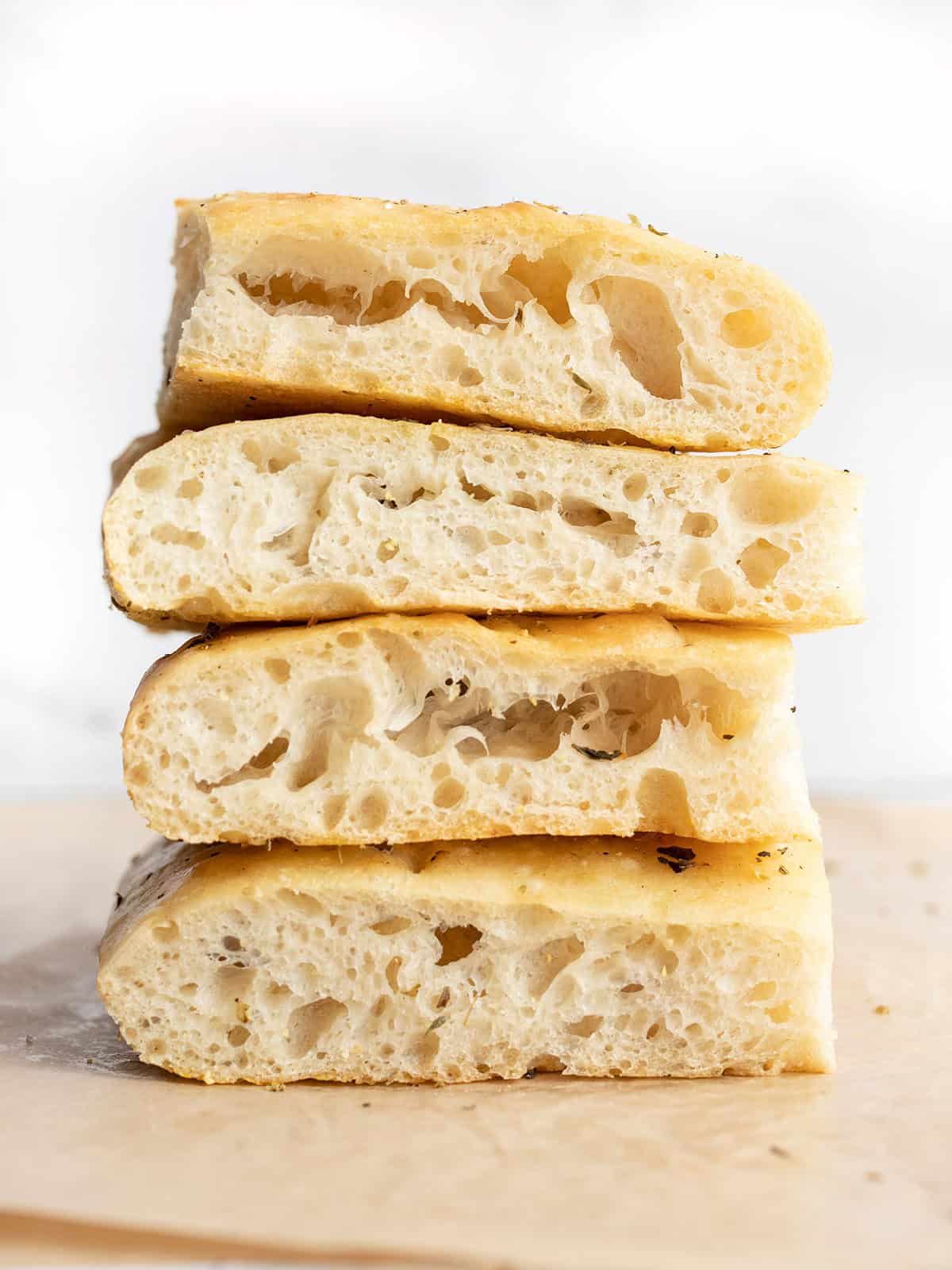
This post contains some affiliate links, which means that we make a small commission off items you purchase at no additional cost to you.
What is Focaccia?
Focaccia bread is an Italian flatbread known for its thick, fluffy texture with plenty of large bubbles. It is often rectangular or circular in shape and is made with high-gluten flour and plenty of olive oil, which gives it a unique texture and flavor. Focaccia can be seasoned with herbs, cheese, or even vegetables and is often used for sandwiches, dipping into soups or sauces, or even as thick base for pizza.
Ingredients for No Knead Focaccia Bread
This super simple no knead focaccia bread recipe only uses a few simple ingredients:
- Flour: Traditionally, focaccia is made with a high-gluten flour that gives it extra strength and a deliciously chewy texture. We crafted this recipe using all-purpose flour to reduce the need to purchase special ingredients. You can use high-gluten flour if you prefer, but the water-to-flour ratio may change slightly.
- Instant Yeast: Because this focaccia recipe uses a no-knead technique, we must use instant yeast which does not need to be bloomed in warm water to activate.
- Salt: Salt helps give the focaccia bread flavor. Without salt, bread can be quite bland and flavorless.
- Water: Water hydrates the flour and helps the yeast activate.
- Olive Oil: Olive oil keeps the focaccia dough from sticking, gives the bread’s crust a wonderful texture, and provides a classic flavor.
- Cornmeal: We use cornmeal to give the bottom crust of the focaccia bread a nice crispy texture, but it is optional.
- Italian Seasoning: A simple Italian seasoning blend is used to give the bread even more flavor, but you can experiment with your focaccia bread with other herbs, spices, cheese, or even vegetables.
Can I Use Whole Wheat Flour?
Yes, you can substitute some of the all-purpose flour for whole wheat flour. Using all whole-wheat flour generally creates a very heavy and dense bread, so I highly suggest using only some, up to 50%, whole wheat flour. You may need to use slightly more water, as whole wheat flour absorbs more moisture than all-purpose flour.
The No Knead Bread Technique
Regular bread baking requires the dough to be kneaded a long time to make the gluten strands line up and form a sort of matrix that gives the dough strength and texture. With no-knead bread, the dough is allowed to ferment overnight. During fermentation enzymes break down the gluten in a process called autolysis, which makes it easier for them to untangle, line up, and form the matrix that usually takes a lot of kneading to form.
An added bonus is that overnight fermentation adds a lot of flavor to the bread. AND, since the yeast has so much time to grow and multiply, you only need to use ¼ tsp yeast, compared to about 2 tsp for a normal loaf of bread! Win-win!
What Do You Serve With No Knead Focaccia?
Focaccia is such a versatile bread! It makes a great side dish with just about any meal, but I think it’s particularly nice with soups and stews. Its hearty texture makes it great for dipping, dunking, and sopping up sauces, stews, and soups. Focaccia bread is also fantastic for sandwiches, especially pressed sandwiches like paninis. You can also use this bread to make pizzas or flatbreads. Simply top it with your favorite cheese, meat, or vegetables and bake again until the cheese is melted and bubbly. Or, if you’re just a bread fanatic like me, slice it into sticks, dip it in some homemade marinara sauce, and call it a day!
How to Store Focaccia Bread
After baking, make sure to allow the focaccia bread to cool completely to room temperature before storing to prevent condensation. Once cooled, you can keep the bread at room temperature in an air-tight container for about two days. If you can’t consume the entire loaf within two days, consider freezing a portion of it for longer storage.
To freeze the focaccia bread, simply let it cool completely until it is room temperature, cut it into slices (whichever size or shape you prefer), then place it in a gallon-sized freezer bag. The frozen no-knead focaccia thaws quickly at room temperature.
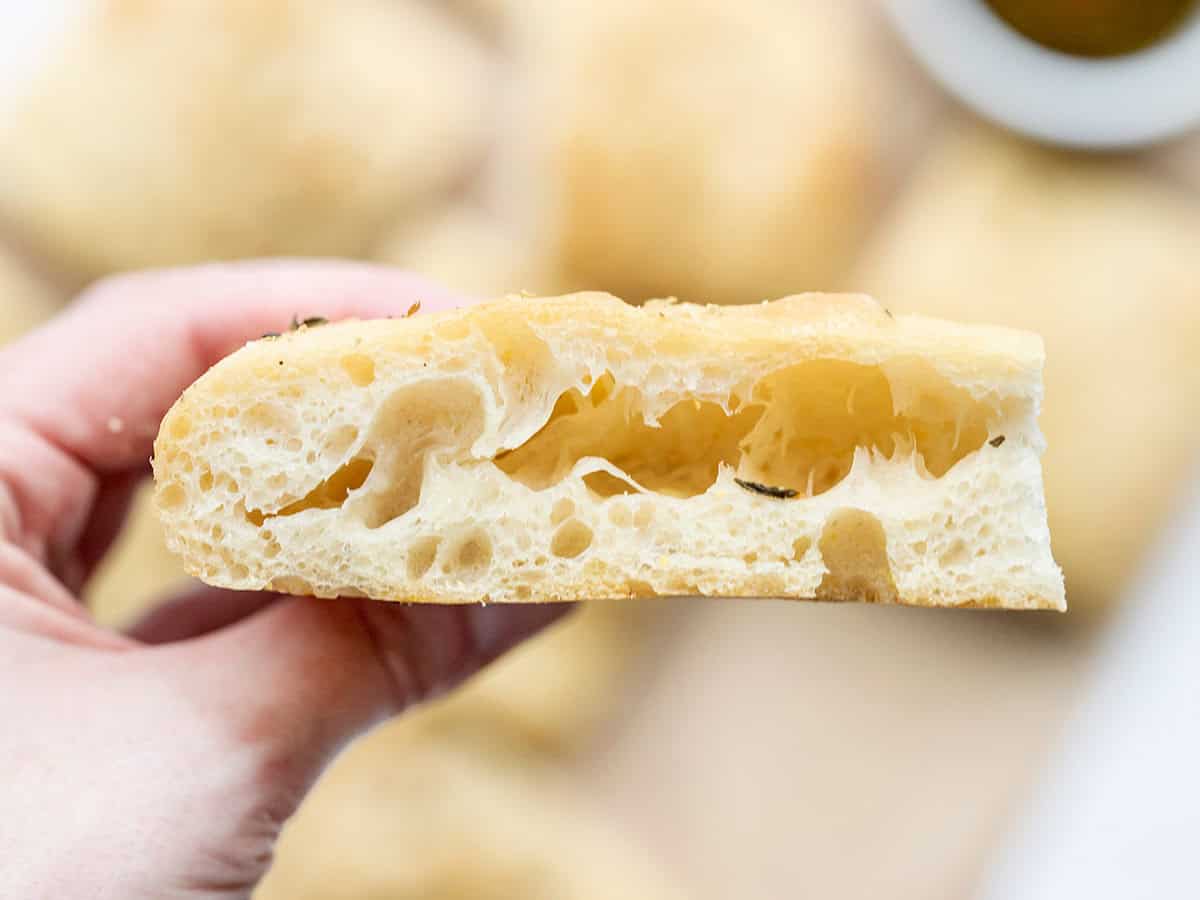
No Knead Focaccia Bread

Ingredients
- 4 cups all-purpose flour ($0.61)
- 1/4 tsp instant yeast ($0.02)
- 1 1/2 tsp salt ($0.03)
- 2 cups water ($0.00)
- 2 Tbsp olive oil, divided ($0.32)
- 2 Tbsp cornmeal ($0.03)
- 1 Tbsp Italian seasoning ($0.30)
Instructions
- The night before, combine the flour, salt and yeast in a bowl. Stir until everything is evenly combined. Add the water and stir until it forms one cohesive, sticky, shaggy ball of dough with no dry flour left on the bottom of the bowl. If there is still dry flour in bowl, add a little water (1-2 Tbsp) until the dough comes together (scroll down to the step by step photos for examples). Loosely cover the bowl and let sit at room temperature for 12-18 hours.
- The next day the dough will be wet, bubbly, and very fluffy. Dust the top of the dough with some flour, then scrape the dough from the sides of the bowl. Turn the dough over on itself a few times until it forms a ball in the center of the bowl.
- Line a baking sheet with foil then drizzle with 1 Tbsp olive oil. Spread the oil to coat the surface of the foil, then sprinkle cornmeal on top of the oil.
- Transfer the dough to the baking sheet. Stretch and pat the dough out into a large rectangle. You may need to dust your hands with flour throughout this process to keep the dough from sticking.
- Drizzle olive oil over the surface of the dough and use a soft brush to spread it evenly over the surface. Sprinkle the Italian seasoning (or any type of herbs) over top. Let the dough rise for another hour.
- Preheat the oven to 425ºF. Using your fingers, press dimples into the risen dough. Bake the focaccia for 20-25 minutes in the preheated oven or until the surface is golden brown. After removing from the oven, allow the focaccia to cool before slicing and serving.
See how we calculate recipe costs here.
Equipment
- Measuring Cups Spoons
- Liquid Measuring Cup
- Enamelware Sheet Pan
Nutrition

How to Make No Knead Focaccia Bread – Step By Step Photos

Start with 4 cups all-purpose flour, ¼ tsp instant yeast, and 1.5 tsp salt. Stir them together until everything is well combined.

Add 2 cups water to the flour mixture. This part will require a little flexibility on your part. You may need to add slightly less or slightly more water depending on the ambient humidity in your home and fluctuations with measuring the flour. I’ll show you what to look for in the next photos.

Stir the water into the flour until it forms a ball of sticky dough and there is no more dry flour left on the bottom of the bowl. In the photo above, the dough is too dry. You can see dry flour on the bottom of the bowl and the dough ball is not cohesive. If this is your dough, add a tablespoon or two more water.

Your dough should look like this. Sticky, but not slimy or shiny, and no dry flour on the bottom of the bowl. This style of dough is much more wet than traditional bread dough. Cover the bowl loosely and allow it to sit at room temperature for 12-18 hours.

After 12-18 hours the dough will look very bubbly and large, like this. Am I weird for thinking that’s gorgeous??

Sprinkle a little flour over the dough to keep your hands from sticking and pull the dough from the sides of the bowl. Turn the dough over onto itself a few times until it forms a sort of ball. Keep your hands well floured as you do this.

This is what the dough looks like after I folded it onto itself a few times. The gluten matrix is well developed. You can tell by how smooth it is and the air bubbles trapped right under the surface.

Line a baking sheet with foil, then drizzle 1 Tbsp olive oil over the surface. Use your hands to spread the oil to evenly coat the surface of the foil, then sprinkle about 2 Tbsp cornmeal over the oil.

Transfer the ball of dough to the prepared baking sheet and press and stretch it out until it fills the entire baking sheet. Drizzle one more tablespoon of olive oil over the surface of the dough, then sprinkle 1 Tbsp Italian seasoning over the surface (you can use a mix of basil, oregano, and red pepper if you don’t have Italian seasoning).

Let the dough rise for one hour (or a little more if your ambient room temperature is on the cool side). When you get close to the end of the rise time, begin preheating your oven to 425ºF. Use your fingers to make dimples all over the dough.

Once the focaccia has risen and the oven is fully preheated, transfer the baking sheet to the oven and bake the focaccia bread for 20-25 minutes, or until it is nicely golden brown on top.

Look at those gorgeous bubbles!

Let the focaccia bread cool before slicing. You can slice it into 12 squares, or into strips, which are nice for dipping and dunking into soups and stews.


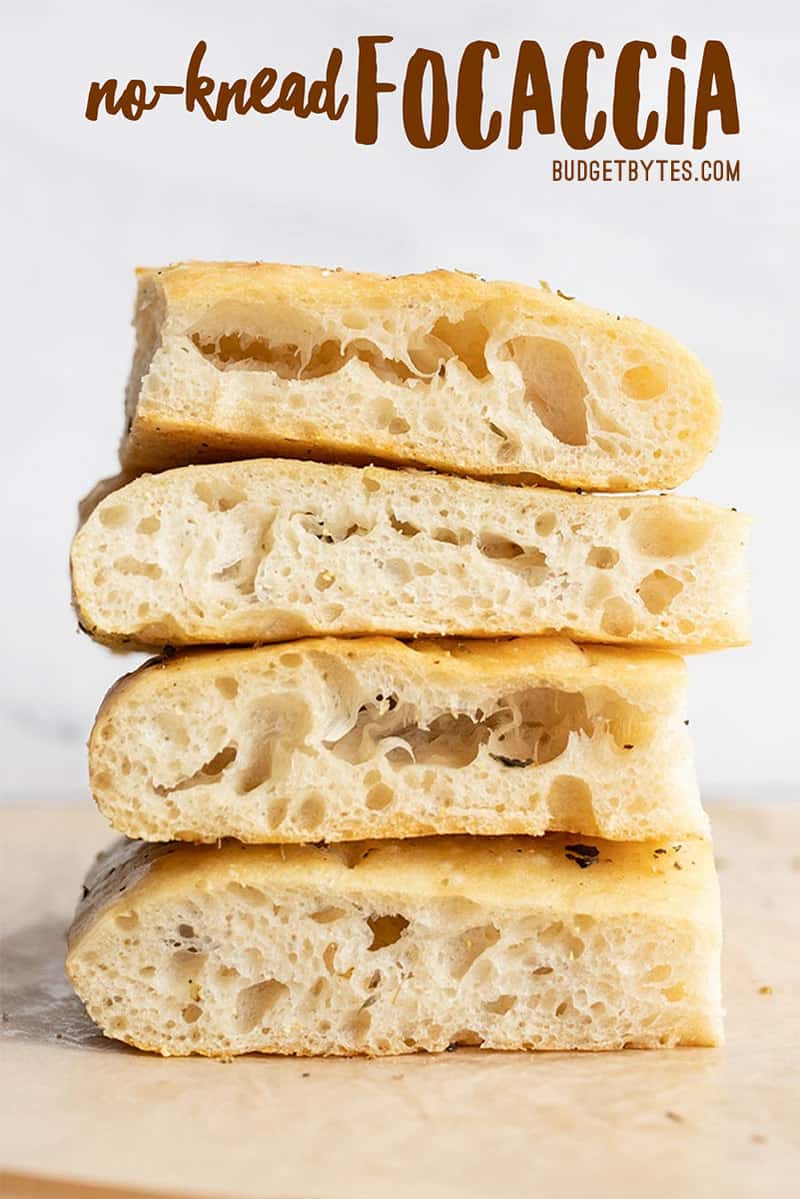
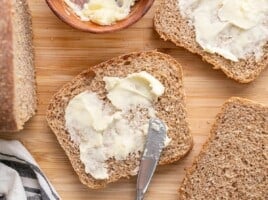
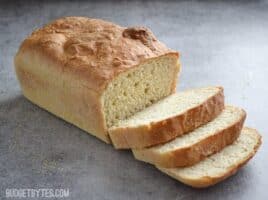
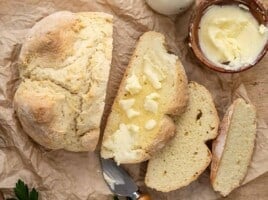
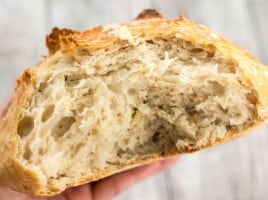
This has been my go-to foccacia bread recipe since I stumbled into this page. I’ve made this thrice and it turns out perfect every single time. Thank you, Beth! 😘
Five months later and I’m still making this! I just made a batch today. This is so good! We especially love making pizza using this as the crust because it’s so flavorful!
This was my first time ever making bread and it turned out pretty good. I subbed whole wheat flour because I ran out of white flour and me and my sister really liked it. I am going to be using it for her birthday dinner later tonight. We have been having a lot of fun making these recipes. Like other people have mentioned, they turned out a little chewy but I am pretty sure that its our fault since we messed up a step but thankfully the recipe was pretty forgiving.
Hi, Europe here. I was trying your recipe and didn’t work out well. Would be possible for you to share the amounts here in grams / kilograms here? It would really help.
Thank you in advance, Kamila
Mine didn’t turn out as bubbly as yours, and it was slightly chewy. Not sure what I did wrong. It was still very tasty though. My husband and I ate probably ate 1/4 of it as soon as it came out of the oven haha. Nothing like fresh baked bread.
I think I want to try making this gluten free. We’ll see!
Beth, I love this recipe and am so glad you’ve updated it! Do you think you could revisit the old No-Knead Ciabatta recipe, too?
Yep! It’s on my list. :D
You mention needing to use a certain kind of yeast, specifically that you cannot use dry yeast that is usually put in water before adding to a recipe. I have always used tradition dry yeast for no-knead bread and the bread has always been a success.
Can the mixture be kept at room temp for over 18 hours?
You don’t want to leave it fermenting too long, or else the yeast will run out of “food” to feast on and the leavening will start to decrease. So, if you have to leave it longer than the suggested time, transfer it to the refrigerator to slow down the action of the yeast.
Not sure what I did wrong but my bread came out really hard on the top. It’s still edible and Good flavor-A bit yeasty, however not sure where I messed up maybe the temperature of the water? I did not realize it should be at room temp until I read it in the comments. I’m going to keep trying until I perfect this I love focaccia!
Looks delicious, but unfortunately didnt work for me. The dough was too sticky to work with, even when adding flour :(
I had the same problem. It lead to quite a bit of frustration. I just can’t seem to have any success ever with making bread. At some point it’s just cheaper to buy it from a baker.
Are the cups used here the US size or metric cups..?
US sized cups :)
Can I use flour instead of cornmeal? Or do you have any other substitutions?
That should work fine. The cornmeal doesn’t go into the dough, so you could even do without it if you want :) It just helps keep the dough from sticking to the baking sheet (although the oil is sufficient on its own) and it helps give a nice texture to the bottom.
Serve it with BB herb tomato soup!
Do you think it will yield the same results if I half the recipe and use a smaller tray? Making it for myself and want to make a smaller batch!
Yes I think that would be fine. You can reduce the servings by half and the ingredients will adjust.
We tried this and it was fabulous to accompany a tomato and mozzarella salad for lunch. One thing we did, which made the house smell wonderful, was replace the tablespoon of olive oil used to spread over the dough before baking with the same amount of oil from a jar of sun-dried tomatoes. Thank you!! (I love that you put no sugar in your breads too.)